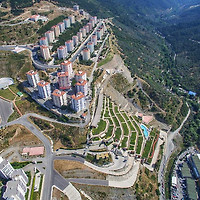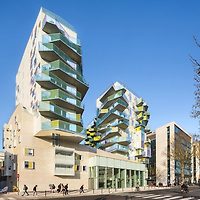
Daegu is the fourth largest city in South Korea and is often referred to as ‘Textile City’, due to its rich history of manufacturing textiles and clothing. As a ‘Fashion Capital’, Daegu is host to a number of annual fashion and textile fairs. However, within the city mega-blocks dominate the urban scale, presenting repetitive silhouettes with little individual identity. In both IPARK developments (Block 1 and Block 2) a pointillist framework of color in two distinct designs - similar to the texture of a fabric or a media screen - is used to connect and dissolve the individual apartment towers into one consolidated mega-block, whilst creating distinct identities for each development within the Daegu cityscape.

On the urban scale, this use of color zoning not only reinforces identity, it also establishes community, reveals principal access points and communicates the relationship between the inside and outside of the two mega-blocks. On the neighborhood scale, the façades transform from a typical grid of windows into a textured and articulated field of color.

In Block 1 the façade construction receives a matrix of options for additional layers that respond differently to each opening and balcony. All together, they form a system of horizontal bands that extrude over the face of the wall, offering the desired depth and shadow effect. Every apartment becomes unique, reinforcing a sense of identity and ownership for its residents. In Block 2 a diagonal pixilation of color blocking is applied to achieve the same results. In both blocks the courtyard facades employ warmer color tones in order to reflect the more intimate, community scale of these urban interiors.

Contrary to popular belief, many of the luxuries commonly associated with high end residential developments are no longer limited to the affluent alone. A growing consciousness of all things beneficial to health and happiness is resulting in a trickling down effect and a widespread societal demand for healthy living environments. Today’s residents want convenient shared amenities which encourage a sense of community and promote physical and psychological well-being.

For the IPARK developments, Hyundai Development Company - which enjoys a market-leading position in the construction of private housing – asked UNStudio to assist in creating apartment developments with a ‘people first’ approach: residences that offer more than merely a place to live, but rather a place to establish a new and healthy lifestyle. The letter ‘I in IPARK stands for innovation and reflects Hyundai Development Company’s commitment to innovate beyond the conventional concept of apartments. ‘PARK’ symbolizes a space which creates enjoyable and comfortable cultural experiences.

As such the buildings in the IPARK developments are organized around large, programmed communal courtyards. Conceived as urban interiors, these courtyards become a shared space for all residents and cater for a wide variety of collective and solo activities. A healthy lifestyle for all ages is supported by a verdant landscape of trees and vegetation, while a forest zone creates a buffer between the personal scale and the surrounding buildings and provides privacy for the apartments on the lower levels. The intent of the landscape design is to create a flexible web of areas that either link to the shared amenities of the development - for example the library, swimming pool, retail outlets, community and fitness centres - or provide safe areas for playing, relaxing and gathering.

Extensive planting is interlaced with trails of varying speeds: from a 400m running track, to a gravel forest trail featuring water elements. Wide boulevards link all the individual areas together while smaller paths connect to the lobby entrances of the buildings. Residents arriving by car can choose to either retreat (go directly to their apartment through their dedicated lobby), or engage (stroll through the landscaped areas and meet with neighbors). As such personal time, space and experience can become valuable assets not only at home, but also in shared spaces and in direct association with nature.

대구 월배아이파크
대구는 한국에서 네 번째로 큰 도시이며 섬유 및 의류 제조에 대한 풍부한 역사로 인해 종종‘ 섬유 도시’라고 불린다.‘ 패션 중심지’인 대구에서는 매년 패션 및 섬유 박람회가 개최된다. 그러나 도시 내에 있는 메가 블록들은 도시의 규모를 지배하며 각각의 정체성이 거의 없는 반복적인 실루엣을 보여주고있다. 두 IPARK 개발(블록 1과 블록 2)에서는 섬유나 미디어 스크린의 질감과 유사하게 두 가지 구별된 설계안에서 색깔을 점묘법을 통해 개별 아파트 타워를 하나의 통합된 메가 블록으로 연결하고 융합한다.

이것은 대구 도시 경관 내의 각각의 발전을 위해 뚜렷한 정체성을 만들어낸다. 도시 규모에서 색깔 구역 지정을 사용하면 정체성을 강화할 뿐만 아니라 공동체를 형성하고 주요 접근 포인트를 드러내어 두 메가 블록의 내부와 외부의 관계를 연결시킬 수 있다. 지역사회적 규모에서 보면 외관은 전형적인 창틀의 질감이 있고 연결된 색상의 영역으로 변환된다. 블록 1에서 외관 건설은 각 개구부와 발코니를 다르게 설계하는 추가 레이어에 대해 선택할 수 있도록 해달라는 요청을 받았다. 모든 요소와 함께 그것들은 원하는 깊이와 그림자 효과를 제공할 수 있는 벽면을 돌출시키면서 수평적으로 그룹을 이루는 시스템을 형성한다. 세대 마다 각자의 정체성과 소유권을 강화시켜주는 특별한 아파트가 된다. 블록 2에서 동일한 결과를 얻기 위해 색깔 블록화의 사선적인 픽셀화가 적용된다.

두 블록 모두 도시 내부의 친밀하고 지역 사회 규모를 반영하기 위해 더 따뜻한 색조를 사용한다. 대중적 신념과는 달리, 고급 주택 개발과 흔히 관련된 사치의 대부분은 더 이상 부유층에만 국한되지 않는다. 건강과 행복에 유익한 모든 것들에 대한 의식이 커지면서 건강한 생활 환경에 대한 광범위한 사회적인 수요가 발생한다. 오늘날의 주민들은 공동체 의식을 북돋고 신체적, 심리적 웰빙을 증진시키는 편리한 공동 편의 시설을 원한다. IPARK 개발을 위해, 개인 주택 건설에서 시장을 주도하는 위치에 있는 현대 산업 개발은 UNStudio에 단지 사는 곳을 제공하는 거주지가 아니라 새롭고 건강한 생활 방식을 수립하는 곳인‘ 사람 우선’ 주제를 적용한 아파트 개발에 지원을 요청했다.

IPARK의 I 알파벳은 혁신의 약자이며 현대 산업 개발 회사의 기존 아파트 개념을 뛰어 넘은 헌신을 반영한다. ‘Park ’는 즐겁고 편안한 문화 체험을 창출하는 공간을 상징한다. IPARK 개발 내에서 이와 같은 건물들은 대규모이며 프로그래밍 된 공동 안뜰 주위에 정리되어있다. 도시 경관의 일부로 생각되는 이 안뜰은 모든 주민들이 함께 사용할 수 있는 공간이 되어 집단적이고 개인적인 다양한 활동이 가능하도록 한다. 모든 연령대의 건강한 라이프 스타일은 나무와 초목이 어우러진 자연의 경관에 의해 뒷받침되며, 숲은 개인적인 공간과 주변 건물 사이에 완충 지대를 조성하고 아파트 저층에 거주하는 이들에게 프라이버시를 제공한다.

조경 디자인의 목적은 도서관, 수영장, 소매점, 지역 사회 및 피트니스 센터와 같은 공동 편의시설과 연결되거나 휴식, 모임, 놀이를 위한 안전한 장소를 제공하는 융통성있는 연결고리를 만들어내는 것이다. 광범위한 식물 지대는 400m 달리기 트랙부터 물을 이용한 자갈 숲 길에 이르기까지 다양한 속도의 산책로로 구성되어 있다. 넓은 가로수 길은 모든 개별 공간을 연결하며 작은 길은 건물의 로비 입구로 연결된다. 자동차로 도착하는 거주자는 전용 로비를 통해 아파트에 직접 들어가거나 조경 지역을 산책하고 이웃과 마주치는 경로를 선택할 수 있다. 그러한 개인적인 시간, 공간과 경험은 집에서 뿐만 아니라 공유된 공간과 자연과의 직접적인 연결은 귀중한 자산이 될 수 있다.











Architect UNSTUDIO
Location Daegu, Republic of Korea
Program Residential
Building area Block1 50,774㎡, Block2 81,901㎡
Gross floor area Block1 199,908㎡, Block2 319,193㎡
Principal architect Ben van Berkel Project architect Block1; Caroline Bos, Gerard Loozekoot with Marianthi Tatari and Joerg Petri, Milena Stopic, Jaap-Willem Kleijwegt, Deepak Jawahar, Gustav Fagerstrom, Colette Parras, Hans Kooij, Tina Kortmann, Patrik Noome / Block2; Gerard Loozekoot with Ren Yee and Tina Kortmann, Filippo Lodi, Paula Ibarrondo, Harlen Miller, Jan Kokol, Roman Kristesiashvili, Machiel Wafelbakker, Wendy van der Kniff and Todd Ebeltoft
Landscape architect Lodewijk Baljon landschapsarchitecten
Client Hyundai Development Company
Photographer Edmon Leong, Rohspace
해당 프로젝트는 건축문화 2018년 7월호(Vol. 446)에 게재 되었습니다.
The project was published in the July, 2018 issue of the magazine (Vol. 446)
'Architecture Project > Multifamily' 카테고리의 다른 글
| Asma Bahceler Residences (0) | 2019.01.15 |
|---|---|
| HYGGE TERRACE (0) | 2018.10.29 |
| Torre Forma ITAIM (0) | 2018.09.11 |
| FULTON A5A1 (0) | 2018.09.10 |
| Color. Relationship. Fragrant. (0) | 2018.08.27 |
마실와이드 | 등록번호 : 서울, 아03630 | 등록일자 : 2015년 03월 11일 | 마실와이드 | 발행ㆍ편집인 : 김명규 | 청소년보호책임자 : 최지희 | 발행소 : 서울시 마포구 월드컵로8길 45-8 1층 | 발행일자 : 매일







